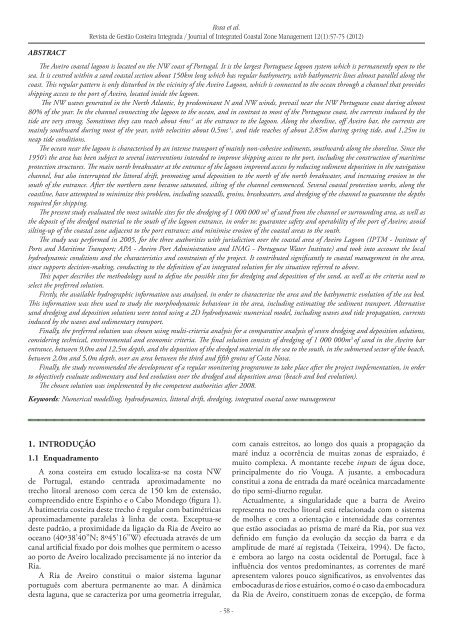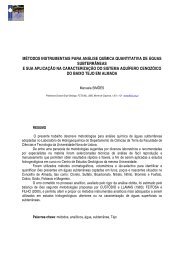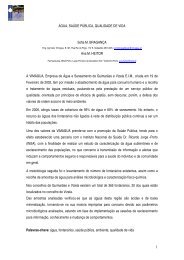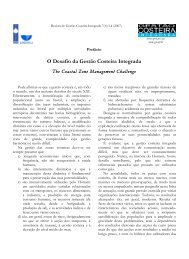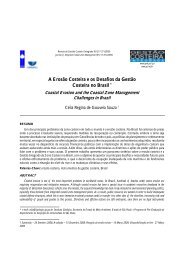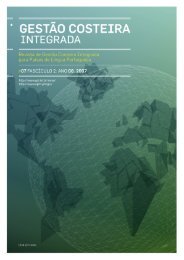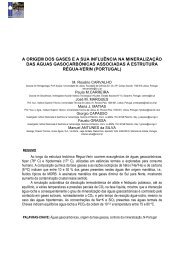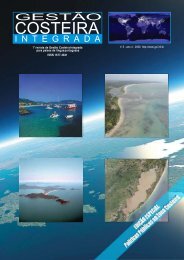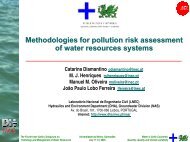Create successful ePaper yourself
Turn your PDF publications into a flip-book with our unique Google optimized e-Paper software.
ABSTRACT<br />
Rosa et al.<br />
Revista de Gestão Costeira Integrada / Journal of Integrated Coastal Zone Management 12(1):57-75 (2012)<br />
The Aveiro coastal lagoon is located on the NW coast of Portugal. It is the largest Portuguese lagoon system which is permanently open to the<br />
sea. It is centred within a sand coastal section about 150km long which has regular bathymetry, with bathymetric lines almost parallel along the<br />
coast. This regular pattern is only disturbed in the vicinity of the Aveiro Lagoon, which is connected to the ocean through a channel that provides<br />
shipping access to the port of Aveiro, located inside the lagoon.<br />
The NW waves generated in the North Atlantic, by predominant N and NW winds, prevail near the NW Portuguese coast during almost<br />
80% of the year. In the channel connecting the lagoon to the ocean, and in contrast to most of the Portuguese coast, the currents induced by the<br />
tide are very strong. Sometimes they can reach about 4ms -1 at the entrance to the lagoon. Along the shoreline, off Aveiro bar, the currents are<br />
mainly southward during most of the year, with velocities about 0,5ms -1 , and tide reaches of about 2,85m during spring tide, and 1,25m in<br />
neap tide conditions.<br />
The ocean near the lagoon is characterised by an intense transport of mainly non-cohesive sediments, southwards along the shoreline. Since the<br />
1950’s the area has been subject to several interventions intended to improve shipping access to the port, including the construction of maritime<br />
protection structures. The main north breakwater at the entrance of the lagoon improved access by reducing sediment deposition in the navigation<br />
channel, but also interrupted the littoral drift, promoting sand deposition to the north of the north breakwater, and increasing erosion to the<br />
south of the entrance. After the northern zone became saturated, silting of the channel commenced. Several coastal protection works, along the<br />
coastline, have attempted to minimize this problem, including seawalls, groins, breakwaters, and dredging of the channel to guarantee the depths<br />
required for shipping.<br />
The present study evaluated the most suitable sites for the dredging of 1 000 000 m 3 of sand from the channel or surrounding area, as well as<br />
the deposit of the dredged material to the south of the lagoon entrance, in order to: guarantee safety and operability of the port of Aveiro; avoid<br />
silting-up of the coastal zone adjacent to the port entrance; and minimise erosion of the coastal areas to the south.<br />
The study was performed in 2005, for the three authorities with jurisdiction over the coastal area of Aveiro Lagoon (IPTM - Institute of<br />
Ports and Maritime Transport; APA - Aveiro Port Administration and INAG - Portuguese Water Institute) and took into account the local<br />
hydrodynamic conditions and the characteristics and constraints of the project. It contributed significantly to coastal management in the area,<br />
since supports decision-making, conducting to the definition of an integrated solution for the situation referred to above.<br />
This paper describes the methodology used to define the possible sites for dredging and deposition of the sand, as well as the criteria used to<br />
select the preferred solution.<br />
Firstly, the available hydrographic information was analysed, in order to characterize the area and the bathymetric evolution of the sea bed.<br />
This information was then used to study the morphodynamic behaviour in the area, including estimating the sediment transport. Alternative<br />
sand dredging and deposition solutions were tested using a 2D hydrodynamic numerical model, including waves and tide propagation, currents<br />
induced by the waves and sedimentary transport.<br />
Finally, the preferred solution was chosen using multi-criteria analysis for a comparative analysis of seven dredging and deposition solutions,<br />
considering technical, environmental and economic criteria. The final solution consists of dredging of 1 000 000m 3 of sand in the Aveiro bar<br />
entrance, between 9,0m and 12,5m depth, and the deposition of the dredged material in the sea to the south, in the submersed sector of the beach,<br />
between 2,0m and 5,0m depth, over an area between the third and fifth groins of Costa Nova.<br />
Finally, the study recommended the development of a regular monitoring programme to take place after the project implementation, in order<br />
to objectively evaluate sedimentary and bed evolution over the dredged and deposition areas (beach and bed evolution).<br />
The chosen solution was implemented by the competent authorities after 2008.<br />
Keywords: Numerical modelling, hydrodynamics, littoral drift, dredging, integrated coastal zone management<br />
1. INTRODUÇÃO<br />
1.1 Enquadramento<br />
A zona costeira em estudo localiza-se na costa NW<br />
de Portugal, estando centrada aproximadamente no<br />
trecho litoral arenoso com cerca de 150 km de extensão,<br />
compreendido entre Espinho e o Cabo Mondego (figura 1).<br />
A batimetria costeira deste trecho é regular com batimétricas<br />
aproximadamente paralelas à linha de costa. Exceptua-se<br />
deste padrão, a proximidade da ligação da Ria de Aveiro ao<br />
oceano (40º38’40’’N; 8º45’16’’W) efectuada através de um<br />
canal artificial fixado por dois molhes que permitem o acesso<br />
ao porto de Aveiro localizado precisamente já no interior da<br />
Ria.<br />
A Ria de Aveiro constitui o maior sistema lagunar<br />
português com abertura permanente ao mar. A dinâmica<br />
desta laguna, que se caracteriza por uma geometria irregular,<br />
com canais estreitos, ao longo dos quais a propagação da<br />
maré induz a ocorrência de muitas zonas de espraiado, é<br />
muito complexa. A montante recebe inputs de água doce,<br />
principalmente do rio Vouga. A jusante, a embocadura<br />
constitui a zona de entrada da maré oceânica marcadamente<br />
do tipo semi-diurno regular.<br />
Actualmente, a singularidade que a barra de Aveiro<br />
representa no trecho litoral está relacionada com o sistema<br />
de molhes e com a orientação e intensidade das correntes<br />
que estão associadas ao prisma de maré da Ria, por sua vez<br />
definido em função da evolução da secção da barra e da<br />
amplitude de maré aí registada (Teixeira, 1994). De facto,<br />
e embora ao largo na costa ocidental de Portugal, face à<br />
influência dos ventos predominantes, as correntes de maré<br />
apresentem valores pouco significativos, as envolventes das<br />
embocaduras de rios e estuários, como é o caso da embocadura<br />
da Ria de Aveiro, constituem zonas de excepção, de forma<br />
- 58 -


